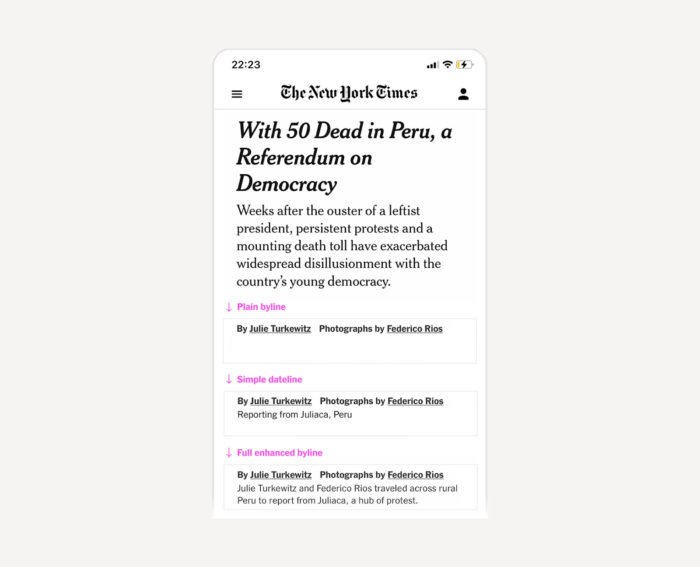
Starting Thursday, New York Times stories online will no longer include a traditional dateline that tells where a story was reported from. Instead, certain stories will have “enhanced bylines” that tells readers more about how journalists did the reporting.
The Times has made changes to its dateline conventions before, eliminating actual dates in 2007. The dateline will still appear in print, though the Times print hub is working on its own experiments to adapt the new format.
Per the email sent to the newsroom by managing editor Marc Lacey and assistant managing editor Matt Ericson:
The Times has been experimenting with enhanced bylines since January 2022, first on the business and international desks, and later expanding to others in the newsroom. Edmund Lee, who was previously a Times media reporter on the business desk and is now an assistant editor on the Times’ Trust team, said the idea for enhanced bylines to replace datelines has been talked about in the newsroom since at least 2017. The Trust team’s research found that readers trust journalism more when they know the process of how it was produced.Instead of “WASHINGTON —” in the lead on our next article from the White House or Capitol Hill, we will write “Reporting from Washington” in an enhanced byline, or include a reference to the location in a broader description of the reporting effort.
Why the change? This new format is plainspoken and leaves no doubt that we have reporters on the ground, a critical measure of the authority of our journalism. Audience research shows that readers are confused by traditional datelines. Many understand that they signify the location of the news but not that we were there.
The old dateline, which dates to the time of the telegraph, does not do justice to reporting from multiple locations. The new form allows us to more fully describe the scope of our news gathering, emphasizing our role as expert eyewitnesses and thus boosting our credibility.
“One of the specific elements of our journalism conventions that have always befuddled readers is the dateline,” Lee said. “People don’t know what datelines mean. When they see Washington or London in all-caps in the lead of a story, they might get that the story took place in Washington or London, but they don’t necessarily know that the reporter was physically present in those locations. A big part of ensuring trust is letting people know we are where we say we are.”
Other U.S. news outlets have also been experimenting with variations of extended or enhanced bylines, typically at the top of a story before the first paragraph.

Vox:



Here’s what a Times enhanced byline looks like on a September 2022 story on how rarely Florida voter fraud cases are prosecuted:

For a story earlier this week on the war in Sudan that’s leading refugees into the neighboring country of Chad:

The Times shared that the reporter on this story on Rwandan refugees said some readers read it because of the information in the enhanced byline:

The enhanced byline field has been built into the Times’ CMS, so reporters and editors can choose from three options: A plain byline with just the journalists’ names; a simple dateline with the journalists’ name followed by “reporting from ______”; or an enhanced byline that includes both dateline information and a description of how the story was reported.
“This is a way to modernize how we do what we do,” Lee said. “It’s more colloquial, it’s more plain-spoken. And at the end of the day, it’s just good journalism to be more transparent and explain how you gather your news.”
Last December, Google updated its search ratings guidelines to prioritize search results that signal “experience” and “expertise.” Lee said the enhanced bylines will help surface Times stories in Google searches, but it wasn’t the reason for the change (“That was just a nice coincidence”).
“We weren’t aware of Google’s pending change till very recently, though we’d been working on enhanced bylines for over a year,” he said. “We’re looking at updating our author pages, which should help with authentication across the internet.”
A plain byline will still suffice for most Times stories. Simple datelines will be applied to any stories reported outside of New York, while enhanced bylines will be applied at the reporters’ and editors’ discretion. The Times’ audience research found that readers most want to know about reporters’ experience and relationship to the subjects they’re covering.
“A small group of these stories will have that [dateline] information, plus additional information about either the reporter’s background or the specific legwork they applied in the story: ‘reviewed hundreds of documents,’ ‘interviewed 30 different people,’ ‘visited refugee sites,’ that kind of thing,” Lee said. “When we feel that an unusual amount of effort went into a particular story — or there’s a particular connection that the reporter may have had to the story, or a particular part of their background or expertise relates to the story — we’ll highlight it in the enhanced byline.”
Lee said the ideal enhanced byline will reveal information about how the reporting was done that isn’t included in the actual story. While the Times Insider section is dedicated to reporting on the behind-the-scenes of the paper and The Daily podcast interviews Times reporters, Times stories themselves typically don’t delve into how reporters did their work “because we’re not the story,” Lee said. But enhanced bylines are another way to show readers that they can trust trust the work.
“We rarely talk about how we gathered what we gathered in the story itself,” Lee said. “Sometimes in a very big story, we will make that very clear and explain up front, but not always. This is a chance to to pull back the curtain.“